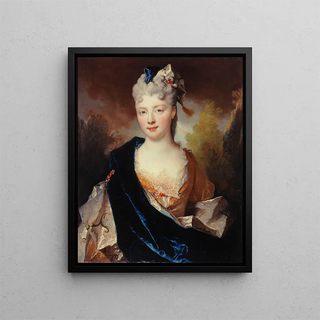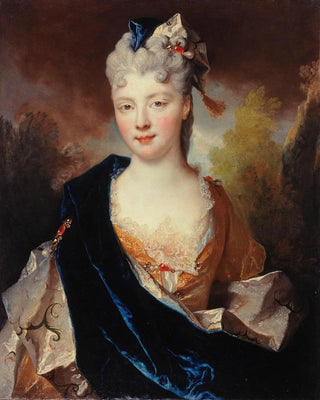Art print | Presumed portrait of Madame la duchesse de Beaufort - Nicolas de Largillière


View from behind

Frame (optional)
Presumed Portrait of Madame la duchesse de Beaufort - Nicolas de Largillière – Captivating Introduction
The "Presumed Portrait of Madame la duchesse de Beaufort" is an iconic 18th-century artwork by Nicolas de Largillière, an undisputed master of French portraiture. This painting, which captures the very essence of the nobility of its time, invites viewers to immerse themselves in a world where elegance and sophistication reign supreme. The duchess, with her penetrating gaze and graceful demeanor, seems to transcend time, offering a fascinating glimpse into aristocratic life under the Ancien Régime. Largillière, through his exceptional talent, manages to immortalize not only the physical appearance of his model but also her aura and social status, making this work a true window into history.
Style and uniqueness of the work
Largillière's style is distinguished by its ability to combine realism and idealization. In this portrait, the duchess is depicted with meticulous care, every detail of her sumptuous dress and carefully crafted accessories demonstrating the artist's skill. The rich colors and subtly diffused light across the canvas create an intimate atmosphere, almost tangible. Largillière employs painting techniques that bring textures to life, whether it is the satin of the dress or the delicacy of the jewelry adorning the duchess. This blend of precision and sensitivity gives the artwork rare emotional depth, allowing viewers to feel the duchess's personality while admiring the artist's technical virtuosity. It is this singularity that makes the portrait a timeless masterpiece, capable of evoking powerful emotions across centuries.
The artist and his influence
Nicolas de Largillière, born in 1656 in Paris, is often regarded as one of the greatest portraitists of his era. Trained in the Baroque painting school, he developed a style that marries Flemish and French influences. Largillière captured the spirit of his time, becoming the preferred portraitist for the aristocracy and high bourgeoisie. His work is not limited to simple representations

Matte finish

View from behind

Frame (optional)
Presumed Portrait of Madame la duchesse de Beaufort - Nicolas de Largillière – Captivating Introduction
The "Presumed Portrait of Madame la duchesse de Beaufort" is an iconic 18th-century artwork by Nicolas de Largillière, an undisputed master of French portraiture. This painting, which captures the very essence of the nobility of its time, invites viewers to immerse themselves in a world where elegance and sophistication reign supreme. The duchess, with her penetrating gaze and graceful demeanor, seems to transcend time, offering a fascinating glimpse into aristocratic life under the Ancien Régime. Largillière, through his exceptional talent, manages to immortalize not only the physical appearance of his model but also her aura and social status, making this work a true window into history.
Style and uniqueness of the work
Largillière's style is distinguished by its ability to combine realism and idealization. In this portrait, the duchess is depicted with meticulous care, every detail of her sumptuous dress and carefully crafted accessories demonstrating the artist's skill. The rich colors and subtly diffused light across the canvas create an intimate atmosphere, almost tangible. Largillière employs painting techniques that bring textures to life, whether it is the satin of the dress or the delicacy of the jewelry adorning the duchess. This blend of precision and sensitivity gives the artwork rare emotional depth, allowing viewers to feel the duchess's personality while admiring the artist's technical virtuosity. It is this singularity that makes the portrait a timeless masterpiece, capable of evoking powerful emotions across centuries.
The artist and his influence
Nicolas de Largillière, born in 1656 in Paris, is often regarded as one of the greatest portraitists of his era. Trained in the Baroque painting school, he developed a style that marries Flemish and French influences. Largillière captured the spirit of his time, becoming the preferred portraitist for the aristocracy and high bourgeoisie. His work is not limited to simple representations






